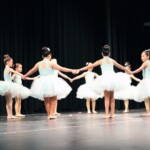Stretching is the key to improving yourself as a dancer and keeping your body safe and healthy.
Types of Stretching
There are several different techniques for stretching muscles, each with advantages and disadvantages. You should consult an experienced teacher here at the Omaha School of Dance or a health care professional to find the best technique for your physique.
However, there are two main types of stretching: static and dynamic.
Static Stretching
Static stretching is a stretch that is held in a particular position. For example, lying on your back with one leg raised in the air and gently easing the leg in toward the chest to stretch the hamstrings. Static stretching is more effective than dynamic stretching for producing long-term flexibility, but should only be practiced when the body is fully prepared.
Dynamic Stretching
Dynamic stretching is a stretch that is an active movement as a result of muscle contraction. For example, circling the ankle or shoulders, or controlled leg and arm swings. This type of stretching takes you to the limits of your range of motion, with no bouncing or jerking. A good dynamic stretch is one that reproduces the movement patterns required for the exercise you are about to undertake. Dynamic stretching should be performed only after a proper warm-up.
When To Do Each Kind of Stretch
The most crucial factor in regards to stretching is to always warm up first. Proper warm-up should start with some light aerobic activity (such as a gentle jog around the studio) to increase your core temperature. When you produce a light sweat, it’s time to engage in some dynamic stretches. Dynamic stretching should start slowly and gradually increase in the speed and power of the movement.
At the end of your cool down after class – when the activity that requires you to be strong and stable has ceased – is a good time to do your static stretches. Believe it or not, stretching to your end-range before class actually reduces strength and stability, as well as increases your risk of injury, so it should be avoided.
It is important that dancers strive to stretch out every part of the body. A good stretching regimen will cover your legs, arms, back, neck, core, ankles, and feet. Stretching can be a fun part of practice and should not be treated as a chore. Try to introduce new stretches occasionally and use tools or partner‐work to help you stretch to keep things interesting.
What are the Benefits?
The benefits of stretching are plentiful and include the following:
- To increase muscle length permanently. For example, stretch the hamstring muscles so that over time we can kick our leg higher to the front.
- To prevent muscle bulk formation, especially the calf muscles which a dancer wants to be strong and slim, not short and bulky.
- To prevent or alleviate delayed-onset muscle soreness. This is when you ache the day after doing a new exercise, or after doing more than you are used to.
- To disperse lactic acid build-up. This can build up if you have worked a muscle really hard.
- To reduce the tension in the muscle. Sometimes a muscle can hurt if we have held an awkward position for a while, or if we are very stressed.
- To increase elasticity temporarily. This is to make our muscles more stretchy in the exercise that follows immediately after the stretching.
- To reduce the risk of muscle injury. If a muscle is more stretchy then it is less likely to be overstretched when we exercise.
Get creative with your stretching regimen in practice and remember to dedicate enough time to stretching to really maximize the benefits of it. It is all about training your body to achieve the results you are aiming for!
Here at the Omaha School of Music and Dance, we have university trained dance teachers; and therefore, they are knowledgeable regarding the proper stretching techniques. Please call 402-515-9639 if you have any additional questions!
We look forward to seeing you in dance class!



